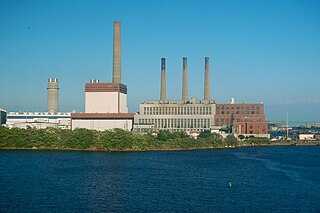
The Lower Colorado River Authority (LCRA) is a nonprofit public utility created in November 1934 by the Texas Legislature. LCRA's mission is to enhance the lives of the Texans it serves through water stewardship, energy and community service. LCRA provides public power, manages the lower Colorado River, builds and operates transmission lines, owns public parks, and offers community services.

A power station, also referred to as a power plant and sometimes generating station or generating plant, is an industrial facility for the generation of electric power. Power stations are generally connected to an electrical grid.

A combined cycle power plant is an assembly of heat engines that work in tandem from the same source of heat, converting it into mechanical energy. On land, when used to make electricity the most common type is called a combined cycle gas turbine (CCGT) plant. The same principle is also used for marine propulsion, where it is called a combined gas and steam (COGAS) plant. Combining two or more thermodynamic cycles improves overall efficiency, which reduces fuel costs.

Cogeneration or combined heat and power (CHP) is the use of a heat engine or power station to generate electricity and useful heat at the same time.
Puget Sound Energy (PSE) is an energy utility company based in the U.S. state of Washington that provides electrical power and natural gas to the Puget Sound region. The utility serves electricity to more than 1.1 million customers in Island, King, Kitsap, Kittitas, Pierce, Skagit, Thurston, and Whatcom counties, and provides natural gas to 750,000 customers in King, Kittitas, Lewis, Pierce, Snohomish and Thurston counties. The company's electric and natural gas service area spans 6,000 square miles (16,000 km2).

Peaking power plants, also known as peaker plants, and occasionally just "peakers", are power plants that generally run only when there is a high demand, known as peak demand, for electricity. Because they supply power only occasionally, the power supplied commands a much higher price per kilowatt hour than base load power. Peak load power plants are dispatched in combination with base load power plants, which supply a dependable and consistent amount of electricity, to meet the minimum demand.

Constellation Energy Corporation is an energy company headquartered in Baltimore, Maryland, United States. The current iteration of the company was founded in 2022 after splitting off from Exelon. The company provides electric power, natural gas, and energy management services. It has approximately two million customers across the continental United States.

The Moss Landing Power Plant is a natural gas powered electricity generation plant located in Moss Landing, California, United States, at the midpoint of Monterey Bay. Its large stacks are landmarks, visible throughout the Monterey Bay Area. The plant is owned and operated by Houston-based Dynegy and currently has a generation capacity of 1020 MW (net) from its two combined cycle generation units. It was once the largest power plant in the state of California, with a generation capacity of 2560 MW, before its two large supercritical steam units were retired in 2016.

Poolbeg Generating Station, colloquially known as The Poolbeg Stacks, is a power station owned and operated by the Electricity Supply Board of Ireland (ESB). There are two stations on the site, the older thermal station containing units 1, 2, and 3 and the combined cycle gas station containing units CG14, CG15 and ST16, which is located toward the eastern end of the site. The six units have a total installed capacity of 1020 MW.

The Huntly Power Station is the largest thermal power station in New Zealand and is located in the town of Huntly in the Waikato. It is operated by Genesis Energy Limited, a publicly listed company. The station has five operational generating units – three 250 MW coal-and-gas-fired steam turbine units, a 50 MW gas peaking plant, and a 403 MW combined cycle gas turbine plant. The station also plays an important role in voltage support for the Northland, Auckland and Waikato regions.

Grain Power Station is a CCGT power station and former oil-fired power station in Kent, England, with operational capacity of 1,275 megawatts (1,710,000 hp) owned by Uniper.
Martin Next Generation Solar Energy Center is the solar parabolic-trough component of an integrated solar combined cycle (ISCC) 1150 MW plant, in western Martin County, Florida, United States, just north of Indiantown. The project was built by Florida Power & Light Company (FPL). Lauren Engineers & Constructors (Abilene, TX) was the EPC contractor for the project. Its construction began in 2008 and was completed by the end of 2010.
Tamar Valley Power Station is a $230 million natural gas-fired power station located in Bell Bay in the Tamar Valley, Tasmania. It is owned by Hydro Tasmania, and is immediately adjacent to the decommissioned Bell Bay Power Station, which is also owned by Hydro Tasmania.
The Canal Generating Plant is a petroleum and natural gas electrical power station in Sandwich, Massachusetts. Canal 1 a baseload unit began operation in 1968 and was for many years the most efficient oil burning plant in the US. Canal 2, a cycling unit began operation in the mid 1970s. The plant was bought by Mirant in 1999. It is located on and named after the Cape Cod Canal. Though today functioning only as a peaking plant, the Canal plant formerly generated the vast majority of the Cape's power in its heyday.
The Osagyefo Barge is a 125 MW barge-mounted gas turbine electric power generating station located at Effasu in the Western Region of Ghana.
The Tunghsiao Power Plant or Tongxiao Power Plant is a gas-fired power plant in Tongxiao Township, Miaoli County, Taiwan. With the installed capacity of 1,815 MW, the plant is Taiwan's second largest gas-fired power plant after Tatan Power Plant.
Basin Bridge Gas Turbine Power Station is a state-owned gas fuel-based power plant located in Basin Bridge, Chennai. It has a capacity of 120 MW and is operated by the Tamil Nadu State Electricity Board.

Energy use in Rwanda is undergoing rapid change at the beginning of the 21st century.

The Mystic Generating Station is a power station in the state of Massachusetts which has the highest nameplate capacity of any station in the state. It is capable of burning both natural gas and petroleum, but mostly burns natural gas.

Gateway Generating Station (GGS), formerly Contra Costa Unit 8 Power Project, is a combined-cycle, natural-gas-fired power station in Contra Costa County, California, which provides power to half a million customers in northern and central California. Gateway Generating Station is on the southern shore of the San Joaquin River, in Antioch, and is one of more than ten fossil-fuel power plants in Contra Costa County.













